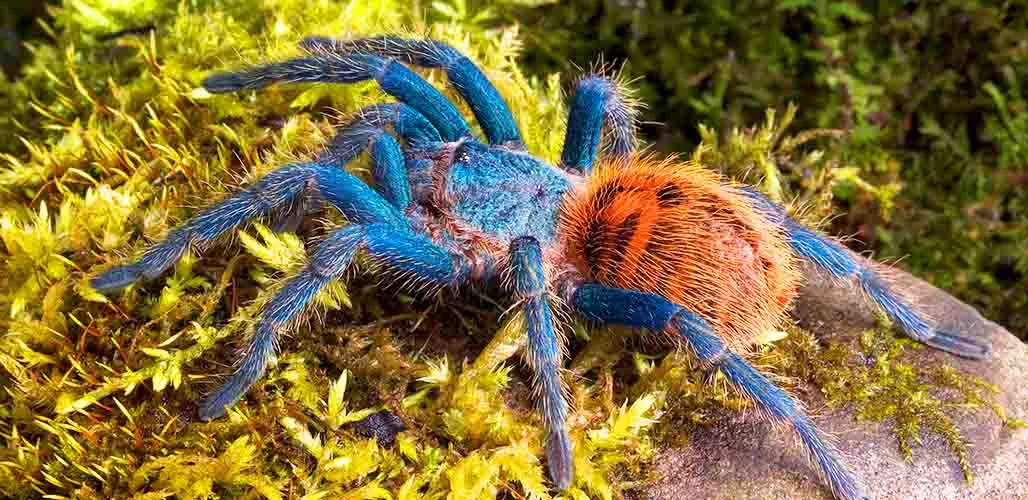Understanding the Blue Bottle Tarantula (GBB)
The Blue Bottle Tarantula, scientifically known as Chromatopelma cyaneopubescens, is a striking and captivating species that has gained immense popularity among tarantula enthusiasts. This tarantula is renowned for its vibrant coloration, docile temperament, and relatively easy care requirements. Providing proper care is essential for these fascinating creatures to thrive in captivity. Understanding the GBB’s specific needs, from enclosure setup to feeding and handling, is the key to ensuring their health, happiness, and longevity. This guide will provide comprehensive insights into every aspect of Blue Bottle Tarantula care, from the basics to more advanced techniques, helping you become a successful GBB keeper.
What is a Blue Bottle Tarantula (GBB)?
The Blue Bottle Tarantula (GBB) is a New World tarantula species, originating from the dry, scrubby regions of the Paraguaná Peninsula in Venezuela. Their common name comes from the stunning iridescent blue coloration that adorns their legs and carapace, contrasting beautifully with their orange-red abdomen and the green hue of their chelicerae. GBBs are known for their arboreal tendencies, often constructing elaborate webs within their enclosures. These spiders are relatively docile compared to some other tarantula species, but it’s essential to remember that they are still venomous and should be handled with caution. The GBB’s beauty and manageable care make it a favorite among both novice and experienced tarantula keepers.
Origin and Habitat of GBB
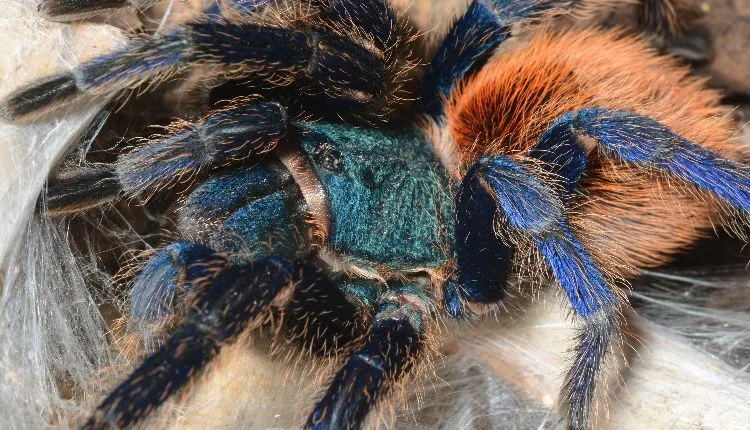
Understanding the natural habitat of the Blue Bottle Tarantula provides valuable insights into their care requirements. In the wild, GBBs are found in the arid scrub forests of the Paraguaná Peninsula in Venezuela. Their environment is characterized by dry, warm conditions with sparse vegetation, including shrubs and cacti. They are adept at constructing webs among the branches and crevices of trees and shrubs. Mimicking these conditions in captivity is critical for their well-being. This includes providing a suitable enclosure, maintaining appropriate temperature and humidity levels, and offering appropriate substrate and decor that allow them to express their natural behaviors and thrive.
Appearance and Characteristics of GBB
The Blue Bottle Tarantula is arguably one of the most visually striking tarantulas. Adult GBBs exhibit a stunning combination of colors. Their legs and carapace showcase a vibrant blue iridescence that shimmers in the light. The abdomen is typically a bright orange-red, and their chelicerae often display a greenish hue. These colors are most pronounced in mature specimens. Their size can range from 5 to 6 inches in leg span. This species is also known for its relatively calm demeanor compared to some other tarantula species, making them more manageable to observe and care for. However, caution is still necessary when handling, and it is always recommended to exercise due diligence.
Setting Up the Perfect GBB Enclosure
Creating a suitable enclosure is fundamental to the health and happiness of your Blue Bottle Tarantula. Considering their arboreal nature, a vertical enclosure is essential. Choose a terrarium with a secure lid to prevent escapes. The size of the enclosure should be appropriate for the spider’s size, with a minimum of 10 gallons for juveniles and larger enclosures for adults. Ventilation is critical, so ensure the enclosure has proper airflow to prevent mold and maintain air quality. Avoid placing the enclosure in direct sunlight, as this can overheat the terrarium and stress the tarantula. Make sure the enclosure is placed in a quiet area.
Choosing the Right Enclosure for your GBB
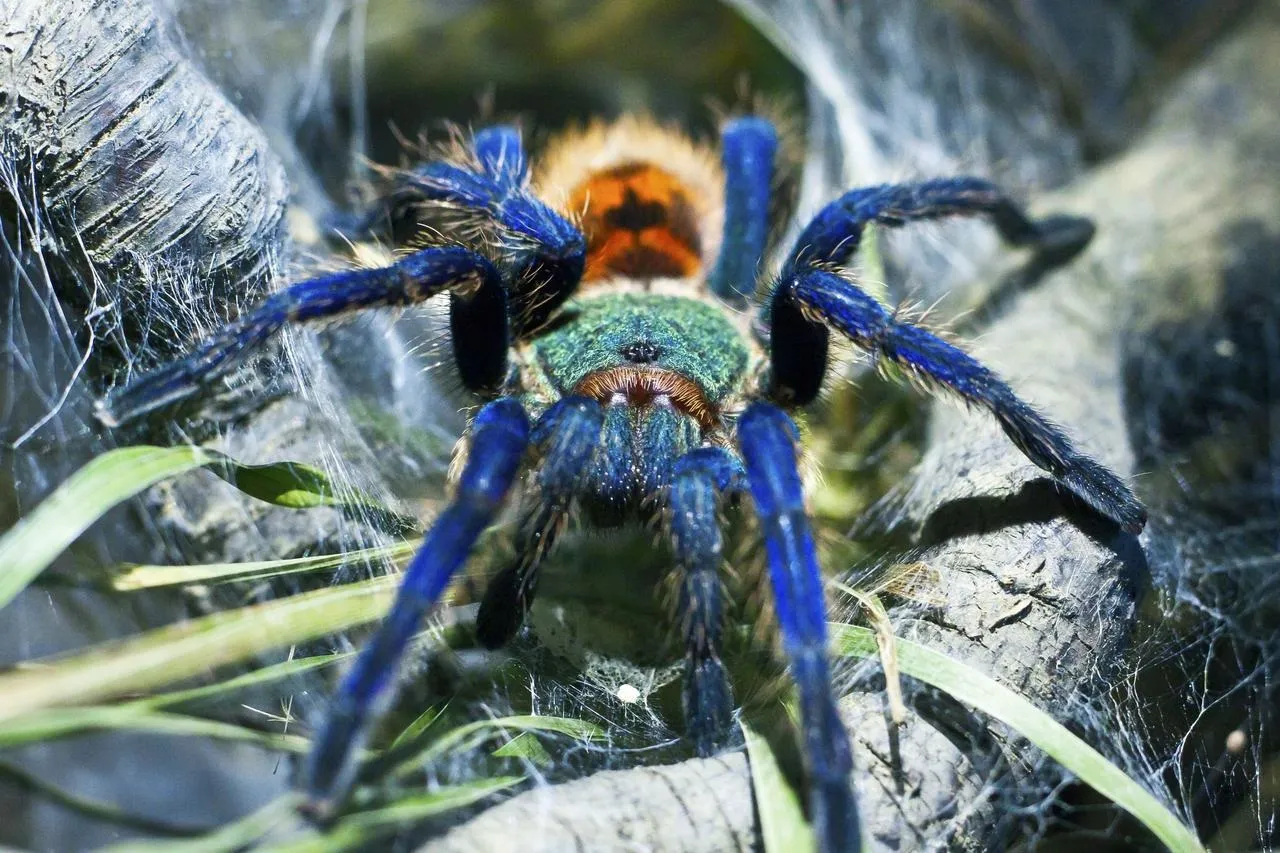
Selecting the right enclosure is vital for providing a comfortable and secure habitat. Glass or acrylic terrariums are popular choices, offering good visibility. For a juvenile GBB, a smaller enclosure like a 5-gallon tank may suffice, while adult tarantulas will require a larger 10-gallon or even a 20-gallon tall enclosure. The enclosure should have a secure, well-fitting lid to prevent escapes and provide adequate ventilation. Front-opening enclosures can be convenient for feeding and maintenance. Prioritize a terrarium that allows for easy observation and meets the specific needs of an arboreal species.
Substrate and Decor for GBB
The substrate and decor in the enclosure not only enhance the aesthetic appeal but also provide essential elements for the tarantula’s well-being. A suitable substrate for GBBs is a mix of coco fiber, peat moss, and a bit of vermiculite, which helps with moisture retention and provides a naturalistic environment. Provide ample anchor points such as cork bark, branches, or artificial plants. These materials allow your GBB to construct webs and mimic its natural arboreal lifestyle. Including a water dish is essential for hydration, and it should be shallow to prevent accidental drowning. Ensure that the decor is secure to avoid any injury to the tarantula.
Temperature and Humidity Requirements
Maintaining the right temperature and humidity levels is critical for a healthy GBB. The ideal temperature range is between 75°F and 85°F (24°C and 29°C). A heat lamp or under-tank heater can be used to maintain the correct temperature, but always ensure that the setup doesn’t overheat the enclosure. Humidity should be kept relatively low, around 50% to 60%. This can be achieved by misting the enclosure lightly with water every few days and ensuring good ventilation. Monitor the temperature and humidity with a digital thermometer and hygrometer to maintain ideal conditions, which are crucial for their molting process and overall well-being.
Feeding Your Blue Bottle Tarantula
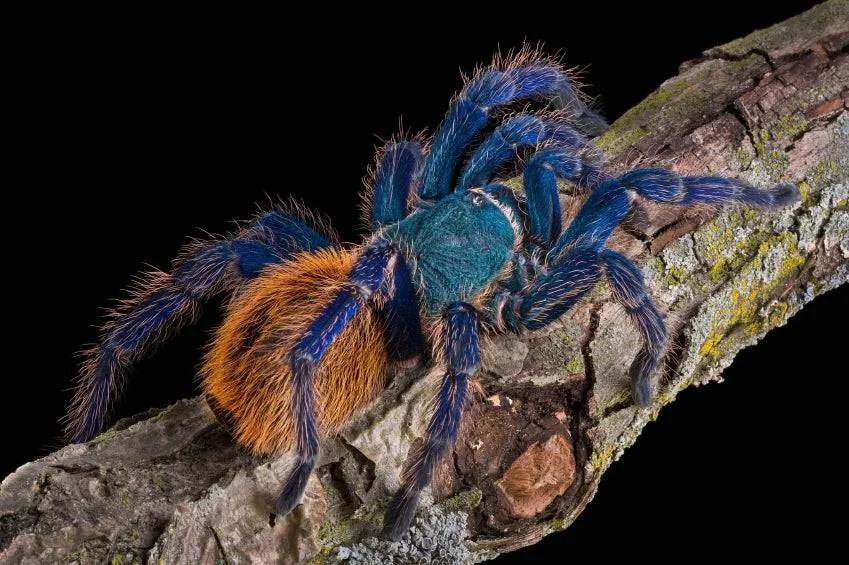
Proper feeding is a cornerstone of GBB care, contributing directly to their growth, health, and longevity. Offering the right foods in appropriate amounts will ensure your tarantula receives all the necessary nutrients. Knowing what to feed your tarantula, how often, and how much is crucial for their well-being. Always remove any uneaten food to prevent mold and keep the enclosure clean. Providing fresh, clean water is also important.
What to Feed a GBB
GBBs are insectivores, meaning their diet consists primarily of insects. A variety of feeder insects is ideal to ensure a balanced diet. Commonly used insects include crickets, mealworms, Dubia roaches, and super worms. Variety is important; avoid relying on a single food source. All insects should be gut-loaded with nutritious food like vegetables and commercial cricket feed before feeding them to your tarantula. This ensures the tarantula receives essential nutrients.
Feeding Frequency and Schedule
The feeding frequency depends on the age and size of the tarantula. Spiderlings and juveniles should be fed 2-3 times a week, while adults can be fed once a week or every other week. Adjust the feeding schedule based on the tarantula’s appetite and body condition. Observe the abdomen; if it is plump, the tarantula is well-fed. Avoid overfeeding. Always remove uneaten insects within 24 hours to prevent them from stressing the tarantula and to maintain a clean environment.
Watering and Hydration for GBB
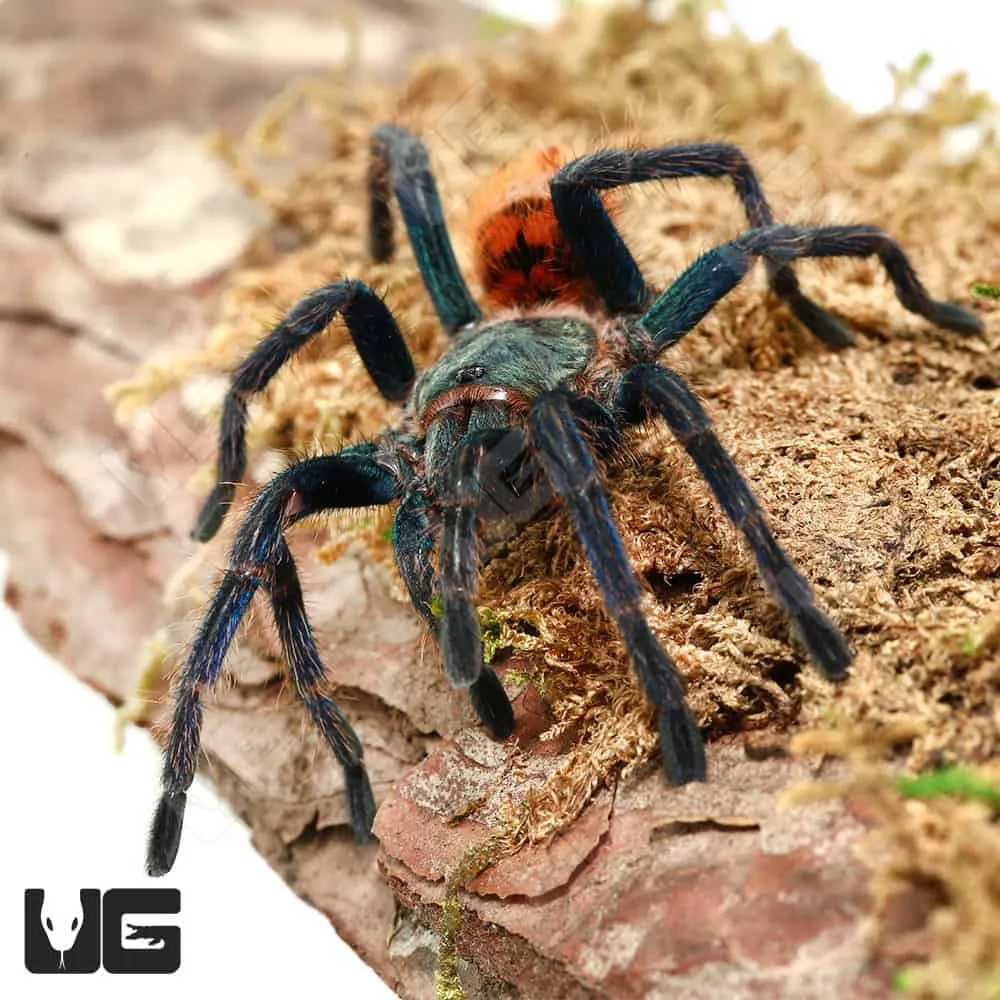
Providing fresh, clean water is essential for GBBs to stay hydrated. A shallow water dish should always be available. It should be sized appropriately, so the tarantula can drink without risk of drowning. Monitor the water level and refill it regularly. In addition to a water dish, you can lightly mist the enclosure every few days, especially during molting, to increase humidity slightly. Always use dechlorinated water to avoid any potential harm from chemicals in tap water. Ensure the humidity is maintained within an ideal range, as this is crucial for successful molting and overall health.
Molting and Growth Stages of GBB
Molting is a natural process where tarantulas shed their exoskeletons to grow. The frequency of molting depends on age; younger tarantulas molt more often than adults. Before molting, the tarantula may become less active, stop eating, and exhibit a darker coloration. Providing a stable and undisturbed environment during this period is vital. Understanding the molting process and what to expect helps you provide the best care possible. It is a fascinating stage to observe, highlighting the resilience and adaptability of these creatures.
Recognizing and Handling a Molting GBB
Before molting, a GBB may exhibit several signs. They will often refuse food for several weeks. Their abdomen may appear darker, and they might create a web mat or close themselves off in their burrow. It is important to avoid disturbing the tarantula during the molting process. Refrain from handling or providing any sudden changes to the environment. After molting, the tarantula will be vulnerable, with a soft exoskeleton. Leave them undisturbed for at least a week to allow their new exoskeleton to harden. Always ensure that there is a shallow water dish available. Observe but do not disturb during the molt.
Growth Rate and Size of GBB
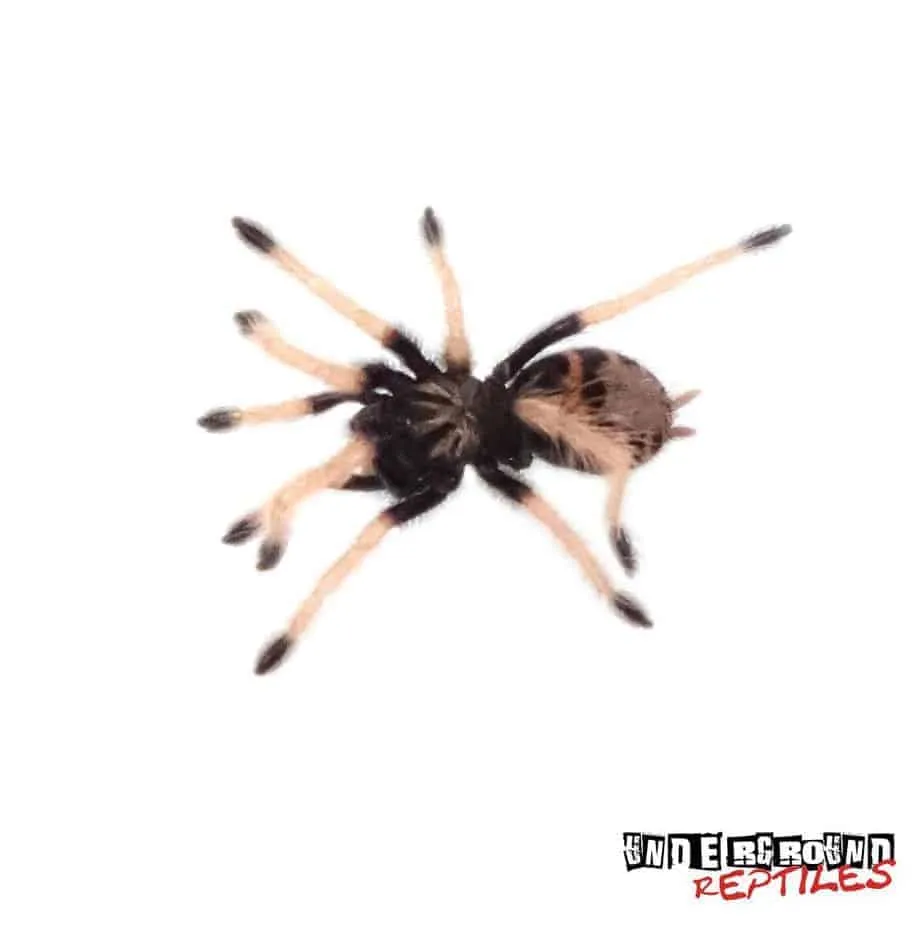
The growth rate of a GBB varies depending on factors like feeding frequency, temperature, and genetics. Spiderlings grow quickly, molting frequently. As they mature, the molting frequency decreases. Adult female GBBs can reach a leg span of up to 6 inches. The males are typically smaller and often have shorter lifespans, as they mature more quickly. Providing consistent care and a suitable environment maximizes their potential for healthy growth. The size and the speed of the growth of the tarantula can be a source of excitement for many keepers.
Common Health Issues and Care
While generally hardy, GBBs can be susceptible to certain health issues if not properly cared for. Understanding these potential problems and their solutions helps you provide the best possible care. By observing your tarantula regularly, you can catch any potential problems early and take the necessary action. Prevention is crucial, but knowing how to identify and address problems promptly is essential for maintaining their health and well-being. Maintaining proper hygiene and a suitable environment is very important.
Preventing and Treating Common GBB Ailments
Common health issues in GBBs include mites, fungal infections, and dehydration. Mites can be a sign of a poorly maintained environment. Improving the substrate and cleaning the enclosure can help control mite infestations. Fungal infections are often related to high humidity levels. Ensuring proper ventilation and adjusting the humidity is crucial. Dehydration can result from insufficient water. Always ensure fresh water is available. If you suspect a more severe health issue, consult with a veterinarian or an experienced tarantula keeper for advice. Early detection and intervention are key to the successful treatment of any health problems.
Handling and Safety Precautions
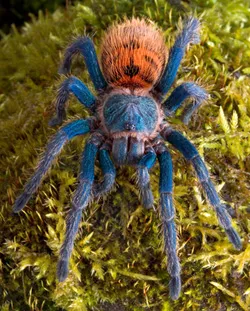
Handling a GBB is generally not recommended. While GBBs are often considered relatively docile, they can still bite if they feel threatened, and their venom can cause localized pain and discomfort. It is better to appreciate them from afar. When handling is necessary, it should be done with extreme caution and only by experienced keepers. Always wash your hands thoroughly before and after handling your GBB. Be aware of the potential risks. If bitten, seek medical advice if needed. Remember, safety should always be the top priority.
Breeding and Reproduction
Breeding GBBs in captivity is possible but requires careful planning and expertise. Successful breeding involves understanding the mating process, providing suitable conditions, and caring for the spiderlings. Both the male and female must be healthy and mature. The process can be fascinating, but it is a commitment. Breeding GBBs can be a complex process. Success requires a good understanding of their reproductive biology. It is not recommended for beginner keepers.
Final Thoughts on GBB Care
Caring for a Blue Bottle Tarantula can be a rewarding experience. By providing the right enclosure, diet, and environment, you can ensure that your GBB thrives. Understanding their specific needs and being attentive to their well-being will allow you to enjoy these stunning creatures for many years. Remember, patience and observation are key to success. Regular care, understanding, and respect are vital to maintaining the health and well-being of your Blue Bottle Tarantula. Enjoy the beauty and the unique experience of keeping these wonderful creatures!
